Great idea from the Twitter Contest Animal Alphabets : drawing endangered animals, one letter for each animal. The world’s wildlife is being lost up to 10,000 times faster than the natural extinction rate.

This small Asian bear (Ursus thibetanus) is also known as the moon bear and white-chested bear and it has a V shaped light chest mark on the black fur. It is in danger of extinction now because of cutting down of the forests where it lives, but also their persistent use in traditional Chinese medicine is a big problem. The Asian black bear considered "vulnerable" by International Union for Conservation of Nature (IUCN) and it is listed as a protected animal in China's National Protection Wildlife Law.
In my drawing bear and cub move towards an untouched wood.
In my drawing bear and cub move towards an untouched wood.

My illustration for Animal Alphabet letter #B - Blue Whale.
This marine mammal (Balaenoptera Musculus) belongs to the baleen whales and it can reach up to 29.9 metres (98 ft) in length and over 181 tonnes (200 short tons) in weight. Its outstanding dimensions makes it the largest animal known to have ever existed. Blue whales were abundant in nearly all the oceans on Earth until the beginning of the twentieth century. For over a century, they were hunted almost to extinction by whalers until protected by the international community in 1966. During the 20th century, the species was almost exterminated due to commercial whaling. It has slowly recovered following the global whaling ban but it remains endangered and faces a number of serious threats including ship strikes and the impact of climate change.
In my drawing the whale defends her calf from whalers while moving towards the safer Arctic Sea.
This marine mammal (Balaenoptera Musculus) belongs to the baleen whales and it can reach up to 29.9 metres (98 ft) in length and over 181 tonnes (200 short tons) in weight. Its outstanding dimensions makes it the largest animal known to have ever existed. Blue whales were abundant in nearly all the oceans on Earth until the beginning of the twentieth century. For over a century, they were hunted almost to extinction by whalers until protected by the international community in 1966. During the 20th century, the species was almost exterminated due to commercial whaling. It has slowly recovered following the global whaling ban but it remains endangered and faces a number of serious threats including ship strikes and the impact of climate change.
In my drawing the whale defends her calf from whalers while moving towards the safer Arctic Sea.
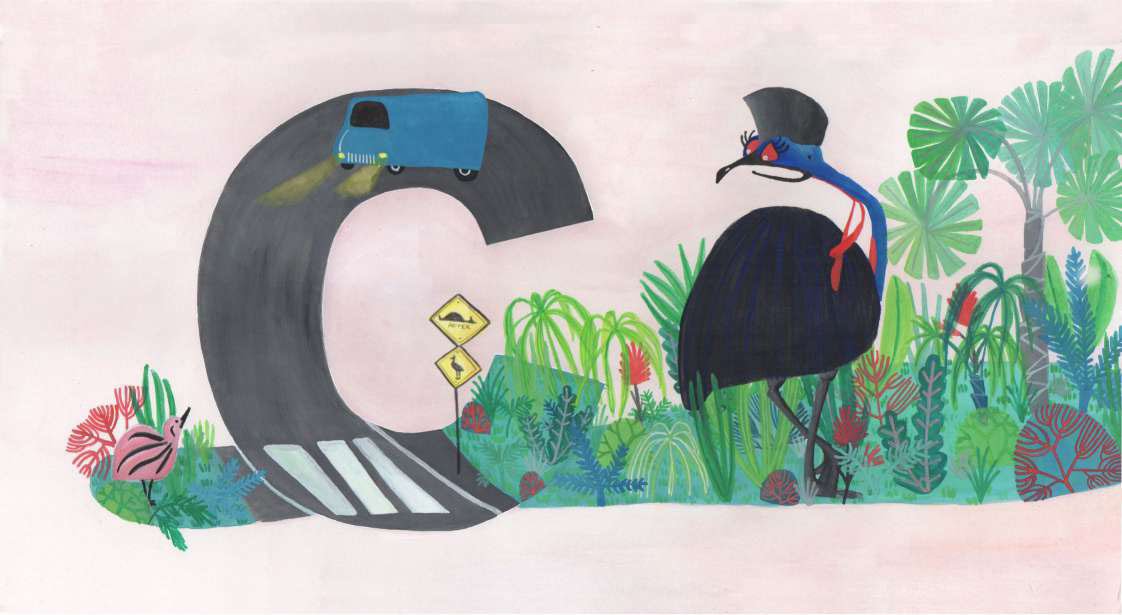
The cassowaries are flightless birds in the genus Casuarius that includes three species. Their most outstanding characteristics is the keratinous skin-covered casque on the bold head. They are native to the tropical forests of New Guinea and northeastern Australia and where these shy birds live typically hidden in the deepest zones. Cassowaries are endangered by their habitat loss and fragmentation that has increased their contact with human activity and its subsequent threatens. Indeed, attacks by dogs and, above all, the strikes by motor vehicles are a major cause of death of cassowaries.
In my drawing the cassowary and her chick are crossing a dangerous road.
In my drawing the cassowary and her chick are crossing a dangerous road.
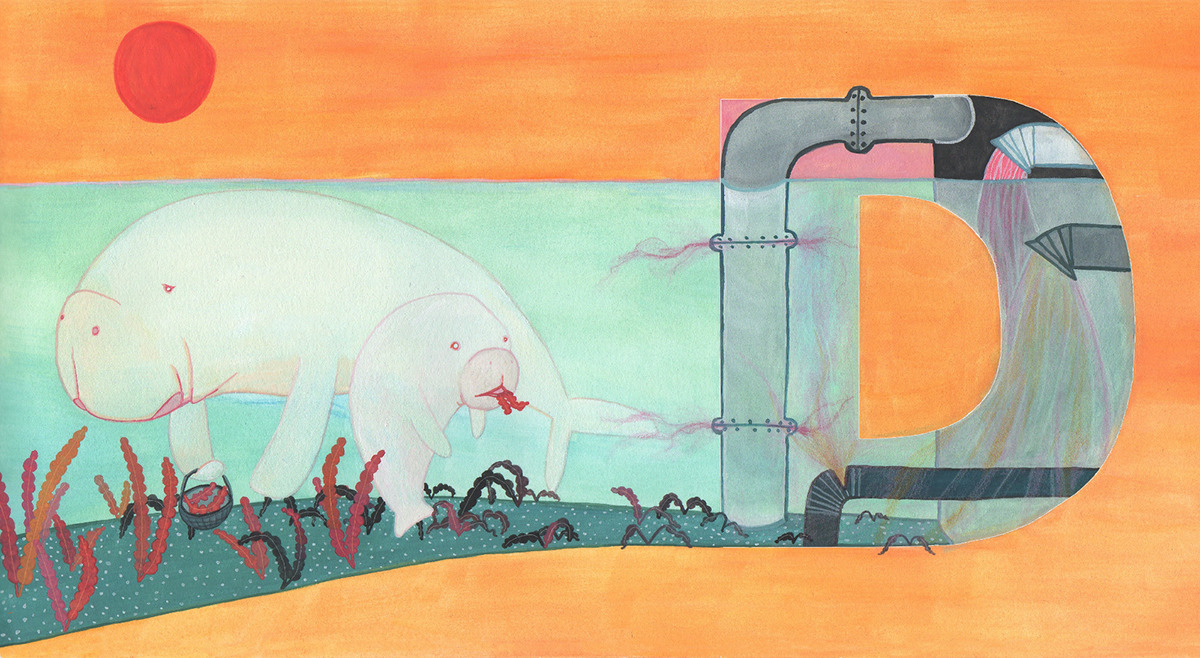
This medium-sized marine mammal (Dugong Dugon) is one of four living species of the order Sirenia, which also includes manatee. The Dugong populate the waters of many countries, mainly in Pacific and Indian Oceans, and Australia is home to the largest population. The dugong's current distribution is fragmented and many populations are believed to be close to extinction, despite being considered protected in many countries. This animal is herbivorous and lives in the shallow waters beside the coastline, where human activities have a strong impact on its habitat. The species is considered vulnerable to extinction and the main threatens are illegal hunting, reckless fishing and environmental degradation. In particular sea pollution can destroy the seagrass meadows that feeds the dugongs, leading to a serious shortage of food.
In my drawing dugong and calf are gathering the scarce seagrass grown in an industrialized area.
In my drawing dugong and calf are gathering the scarce seagrass grown in an industrialized area.

Long-beaked echidna (Zaglossus) includes three species, all of them native of New Guinea only. This animal looks like a spiky ant eater and it is the only mammal, with Platypus, that lays eggs. It is nocturnal and it lives in the deep forest, often burrowing during daytime. However the population of echidnas only occupy the most remote zone of the island and it is considered critically endangered. The species decline has anthropogenic causes and it is mainly due to overhunting. Nevertheless its traditional hunt is still permitted and practised
In my drawing, echidna and puggle are hiding in a burrow from hunters and they are watching the family photobook.
In my drawing, echidna and puggle are hiding in a burrow from hunters and they are watching the family photobook.
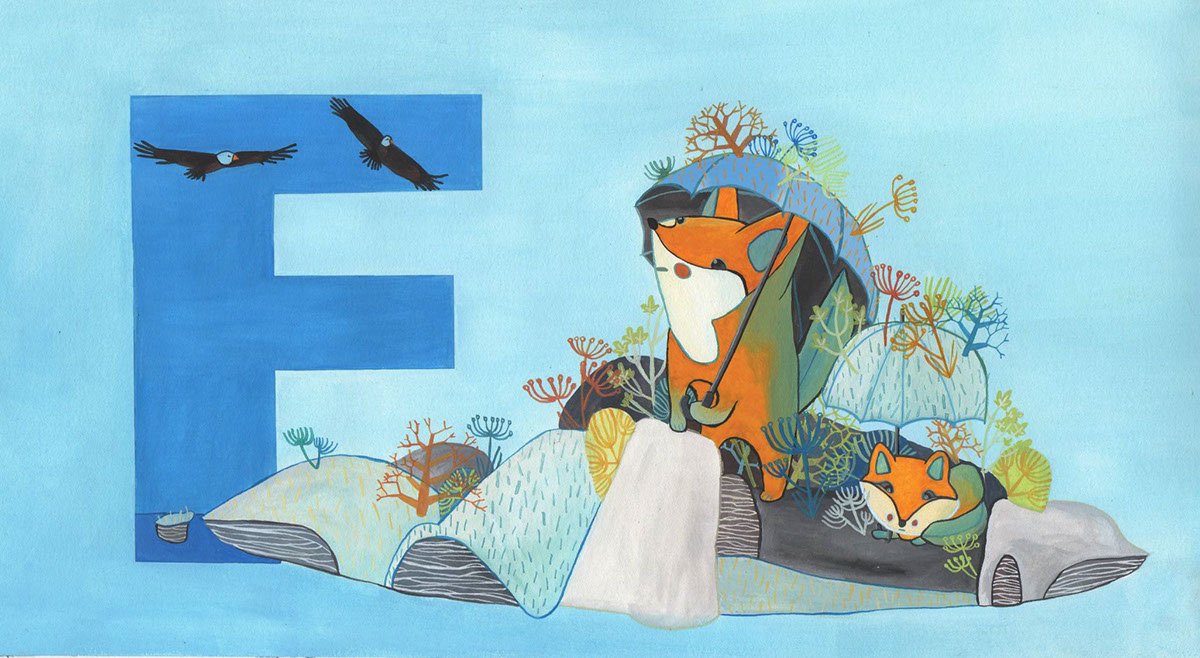
The island fox (Urocyon Littoralis) is a small fox that lives in Californian Channel Islands. It evolved differently from continental foxes due to geographical insulation and it present unique characteristics on each of the six islands it lives on. The island fox became critically endangered to extinction since the 1990s. The decimation of the foxes was caused by the migration of golden eagles towards the channel islands, which started feeding with foxes. The golden eagle is not native of the islands, but it replaced the bald eagle, which was decimated by DDT exposure in the 1950. While bald eagles subsisted on fish, golden ones started preying on the island fox population. After many conservation actions, the foxes population has started to recover and the species is now listed as near threatened.
In my drawing fox and pup hide from the eagles under mimetic umbrellas.
In my drawing fox and pup hide from the eagles under mimetic umbrellas.

All the subspecies of gorilla are enlisted on the IUCN redlist as critically endangered. Among them the mountain gorilla (Gorilla beringei beringei) is the most threatened. It lives in the cloud forest on the mountains of central Africa, in particular the Virunga and Bwindi National Park. It's been estimated that only less than 100 specimens survive. The major threats are poaching and, above all, habitat loss and fragmentation. The human settlement has rapidly increased in the gorilla territories during the last century and this problem was accentuated by the wars in Congo, Rwanda and Uganda. The deforestation and ground exploitation for agriculture has lead to a strong reduction of the suitable living space for gorillas. Only recently the mountain gorilla population increased again, thanks to the conservation efforts. However these animals remains critically endangered and their survival depends on the conservation activities.
In my illustration the gorilla and its baby are climbing towards higher mountains looking for untouched forest.
In my illustration the gorilla and its baby are climbing towards higher mountains looking for untouched forest.

Among the sea turtles, hawksbill sea turtle (Eretmochelys imbricata) shows a characteristic tapered head and a particularly beautifully patterned shell. Indeed the turtle has been hunted for centuries to exploit its shell as a decoration endangering the species survival. It's estimated that the population has declined 80% in the last 100 years and the hawksbill sea turtle was enlisted as critically endangered in 1996, even though the hunt was illegal since many years. Nowadays not poaching is not the only danger, but pollution and destruction of the nesting sites due to coastal development are the main threats to the turtles.
In my illustration the turtle protects her eggs on a floating nursery.
In my illustration the turtle protects her eggs on a floating nursery.

The Indian Elephant ( Elephas Maximusis Indicus) is one of the three subspecies of Asian Elephant. It lives in the grasslands and forests of mainland Asia, being mostly diffused in India an it lives a predominantly nomadic life. Due to this habit, it needs a wide extension of wild habitat and thus it suffers the increase of human settlements, streets, cultivations and land exploitation in general. Habitat loss, fragmentation and degradation is the primary threaten for Indian Elephants, which are listed as Endangered by IUCN since 1986. It has been estimated that the wild population has declined 50% in the last three generations.
In my illustration elephant and its calf are looking for an intact territory.
In my illustration elephant and its calf are looking for an intact territory.

The Javan Rhino ( Rhinoceros Sondaicus) is a small Asian rhinoceros that historically inhabited the rain forests and grasslands of Southeast Asia, the islands of Java and Sumatra, China and India. Now it can be considered the rarest large mammal on Earth since only one population counting fewer than 100 Javan Rhinos survive in the wild. The decimation of the species is mostly due to poaching for the collection of horns and trophy hunting. The horns are highly valued in Chinese traditional medicine and they are belived antidotes for snake venom by some tribes in Vietnam. The habitat loss is another cause of the population decline and especially the extensive use of napalm, defoliation from Agent Orange and aerial bombing during the Vietnam war almost cause the extinction of the last mainland Asian population in the 1970s. However, the last individuals in Vietnam survived in Cat Tien National Park until 2010, when the last Javan Rhino was found shot and horn chopped. The species is now considered extinct in Vietnam and the unique population of wild is found Javan Rhinos in Ujung Kulon National Park, Indonesia. The Ujung Kulon peninsula is located at the western tip of Java. After the eruption of Krakatoa in 1883, the peninsula was abandoned by people, but soon recolonised by wildlife. Javan rhinoceros found a refuge in Ujung Kulon, which became a national park and and then href=" UNESCO World Heritage Site in 1991. The species is critically endangered and, even in the protected area, the remaining individuals are still at risk from disease and loss of genetic diversity.
In my illustration little rhino is looking for mates to play basketball.
In my illustration little rhino is looking for mates to play basketball.

Kakapo ( Strigops Habroptila ) is the world's only flightless parrot and the heaviest parrot of the world. It is a nocturnal, herbivorous bird native from New Zealand where it came to occupy the ecological niche that is filled elsewhere by mammals. The decline of Kakapo population started after the arrival of Māori because of hunting. However the true decimation of kakapos occurred when the European settlers introduced mammalian predators, like cats and mustelids. The kakapo's adaptation resulted useless against these new enemies and so the parrots fquickly died wherever the mammalian colonisation took place, eventually surviving only in the remotest zones. By the end of the last century it was clear that Kakapos were about to extinct unless taken to a predator-free habitat. In 1989 the Kakapo Recovery Programme was developed and the last 65 individuals were transferred onto four islands, where the birds are protected and monitored. In 2016 this critically endangered species counted 154 living individuals, most of which have been given names!
In my illustration kakapo is checking if the forest is safe, but the chick might have seen someone dangerous...
In my illustration kakapo is checking if the forest is safe, but the chick might have seen someone dangerous...
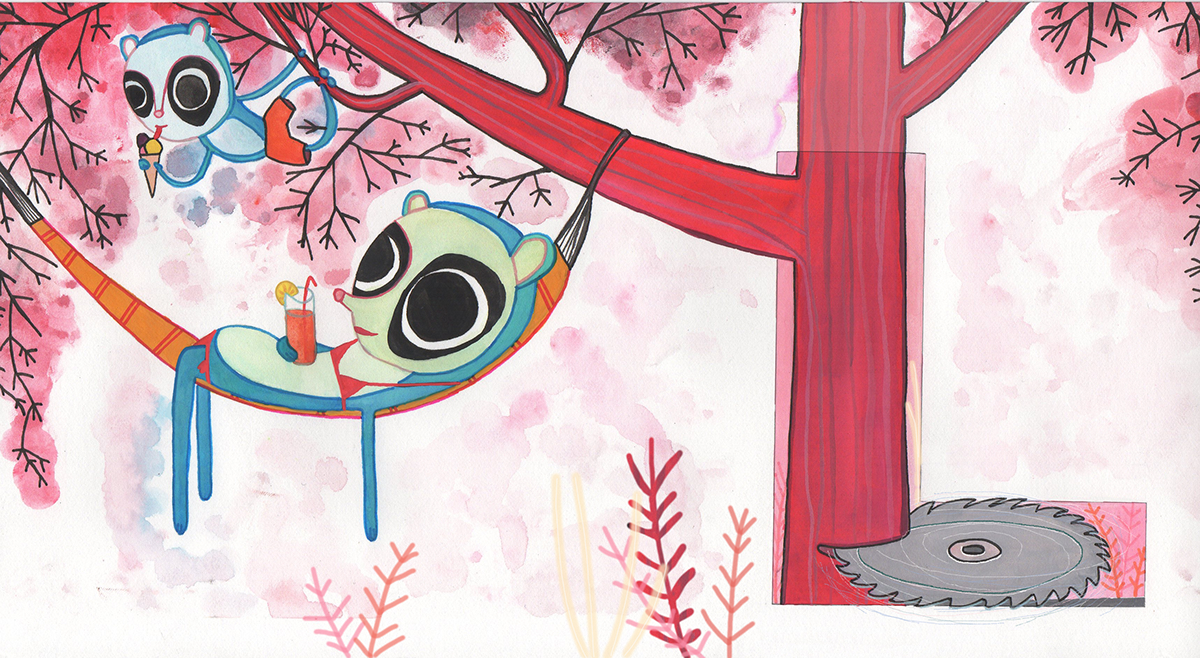
Slender loris (Loris) is a genus of primate that includes two species, red and gray slender lorises. It is native to India and Sri Lanka, where it is found in forests. Lorises have nocturnal and arboreal habits and they travel along the top branches of trees extremely slowly. The decline of slender loris population is due to the destruction and fragmentation of their habitat and to the poaching activity. Conservation efforts are ongoing to monitor the distribution range of slender lorises.
In my illustration, the lorises are enjoying summertime in the forest, but they didn't notice the saw that is cutting their tree!
In my illustration, the lorises are enjoying summertime in the forest, but they didn't notice the saw that is cutting their tree!

The Military Macaw (Ara Militaris) is a larege parrot with predominantly green plumage. The wild birds inhabits the forests of Mexico an South America, even though the Military Macaw is often bred in captivity for pet trade. These parrots are now protected from being captured for trade by CITES, the Convention on International Trade in Endangered Species of Wild Fauna and Flora. Nevertheless their capturing for pet trade industry coupled with habitat loss led to a significant decrease of the population of military macaw, that is listed as vulnerable in IUCN Red List since 2013.
In my illustration, a military macaw and its chick have just escaped from their urban cage and are trying to find their way back to the forest.
In my illustration, a military macaw and its chick have just escaped from their urban cage and are trying to find their way back to the forest.
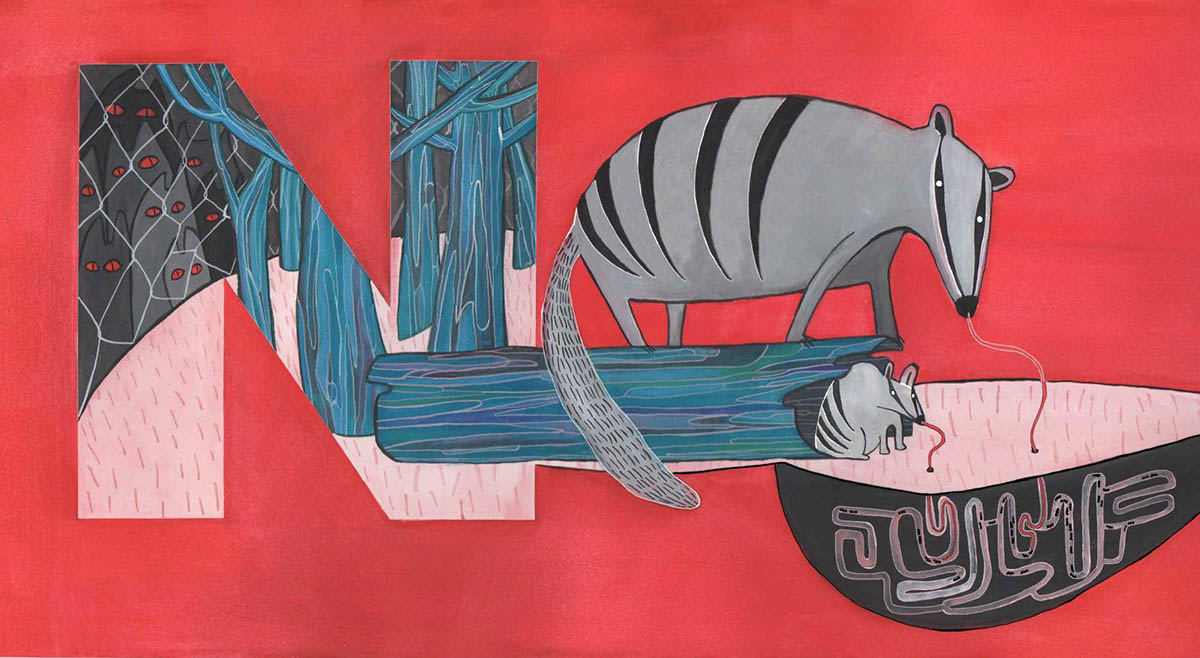
The Numbat (Myrmecobius fasciatus) is small Australian marsupial that lives in Eucalypt woodlands and eats termites exclusively (it is also known as banded anteater). Once diffused across the southern part of Australia, Numbat's range has drastically decreased after the European colonization of the continent. The introduction of new mammalian predators, red foxes in particular, led almost to the extinction of Numbats. Nowadays they are enlisted as endangered animals and only two natural populations remain in fox-free protected areas in south-west od Western Australia. The estimated population counts less than 1000 individuals.
In my illustration mother and baby numbat are looking for ants in the underground, only the wire fence protect them from a lot of hungry foxes...
In my illustration mother and baby numbat are looking for ants in the underground, only the wire fence protect them from a lot of hungry foxes...

Orangutans (Pongo) are Asiatic great apes native to Indonesia and Malaysia and are divided in three species (Bornean, Sumatran and Tapanuli Orangutan). They are intelligent arboreal ape that spend nearly all their time in the threes. All the populations of orangutans have drastically declined primarily due to habitat loss caused by human activities and deforestation. In particular, during the last twenty years orangutans lost approximately the 80% of their habitat due logging, forest fires and tropical forest conversion to palm oil plantations. All the three species of orangutan are now considered critically endangered and conservation efforts are ongoing to improve sustainability and let these animals survive in the wild.
In my illustration mother and baby orangutan are escaping from the fire that is destroying their forest.
In my illustration mother and baby orangutan are escaping from the fire that is destroying their forest.
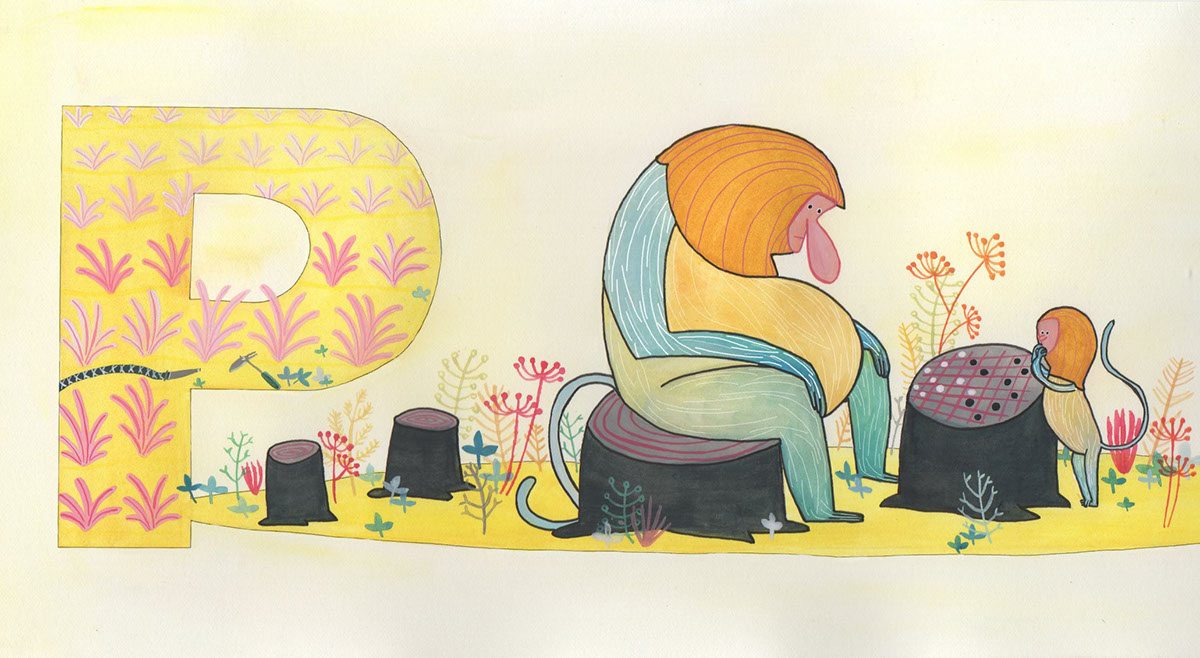
Proboscis monkeys (Nasalis Larvatus) are charaterised by an unusually large nose, or proboscis, that can reach 17 cm in males. Proboscis monkey is endemic of the island of Borneo, where it inhabits coastal areas and lowlands along rivers. It is an arboreal monkey, but it is a good swimmer as well and it usually lives in proximity of a water source. This species is listed in IUCN Red List as endangered since its population has decreased by more than 50% in the last half century and nowadays it counts about 7000 individuals only. The main threat is habitat loss and fragmentation due to forest logging for timber, oil palm plantations and human settling.
In my illustration mother and baby monkey are using a stump to play chess, while their home forest has been logged and replaced by a cultivation.
In my illustration mother and baby monkey are using a stump to play chess, while their home forest has been logged and replaced by a cultivation.
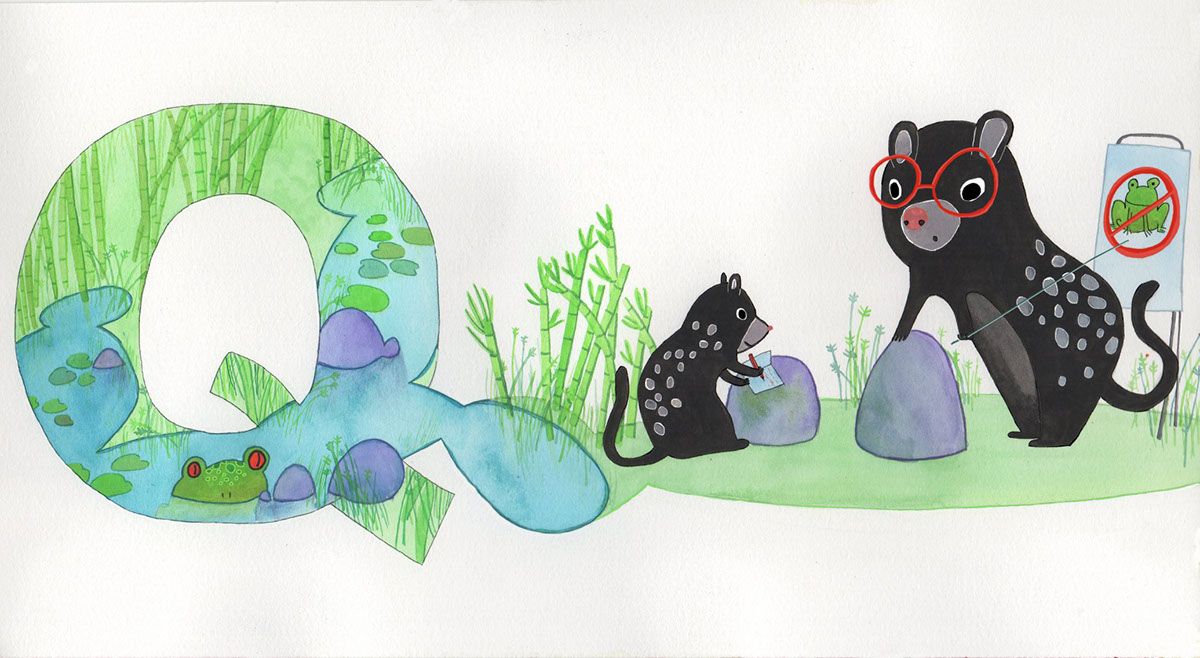
Quolls (Dasyurus) are small marsupials native to Australia and New Guinea. They use a wide range of habitats and each of the six species of this genus inhabits distinct geographical areas. Quolls are nocturnal and carnivorous animals and one matter on their conservation is related to their feeding. They are threatened by toxic cane toads, an American species introduced to Australia after the European colonisation of the country. In particular the Northern quoll population has been decimated by such poisonous toads; a conservation project is now teaching to quolls to avoid eating these amphibians. By the way all the species of quolls have drastically declined after the European colonisation due to habitat loss and fragmentation, which still are primary threats.
In my illustration a teacher quoll is teaching to a pup to stay away from cane toads.
In my illustration a teacher quoll is teaching to a pup to stay away from cane toads.

Red Pandas (Ailurus Fulgens) are also called lesser pandas and red bear-cats. They are Asian mammals native to the forests of Himalayas and they range from the foothills of western Nepal to China. Red Pandas are arboreal and they are strongly associated with montane forests with dense bamboo understorey, which is their main food. This species is listed as endangered in IUCN red list and the major threats are habitat degradation, loss and fragmentation. Red pandas are also threatened by hunting and poaching for pet trade. Their population has declined by 50% over the last twenty years and it is estimated that less than 10.000 individuals remain.
In my illustration a red panda and its cub are sleeping in the logged forest.
In my illustration a red panda and its cub are sleeping in the logged forest.

Snow Leopards (Panthera uncia) are found in the mountain ranges of Central Asia. These large cats are characterized by a whitish fur with black spots and rosettes. They are adapted to their cold high-altitude habitat, being usually solitary and highly elusive. The species is listed as Vulnerable on the Red List of Threatened Species. It's estimated that less than 7000 individuals are left in the wild). The major threats to the endangered cat is poaching for the illegal trade of skin and herds protection. It's been reported that hundreds of leopards per year are killed. Other important issues involves the cats' habitat exploitation for human activities, mining and other large-scale development.
In my illustration the snow leopard cub is attracted by a trap hidden in the snow, while his mother is calmly sleeping.
In my illustration the snow leopard cub is attracted by a trap hidden in the snow, while his mother is calmly sleeping.

The Tansy Beetle (Chrysolina Graminis) is a bright green beetle which primarily uses tansy as its host plant. This plant is repellent to most insects, but tansy beetles are resistant to the volatile chemicals of Tansy on which they feed as both larvae and adults. Tansy grows in fen lands and banks of rivers, that consequently are tansy beetle habitat as wel. The species is declining in the most countries where it is found and it is considered "Nationally Rare" in the United Kingdom. The decline of the beetle is mainly due to habitat loss due to drainage and arable conversion. In the UK they are found only in a small area of the banks of the River Ouse.
In my illustration two beetles are enjoying their Tansy house and kid beetle is on the swing.
In my illustration two beetles are enjoying their Tansy house and kid beetle is on the swing.

The Ulysses Butterfly (Papilio Ulysses) is a large blue butterfly which inhabits tropical rainforests. In Australia the butterfly depends on Euodia trees, where they lay eggs and feed as caterpillars. The destruction of such trees endangered but planting new pink flowered doughwood has increased Unlysses butterflies numbers.
In my illustration an ulysses butterfly is growing a plantation of Euodia, a caterpillar sits on a leaf of a tree.
In my illustration an ulysses butterfly is growing a plantation of Euodia, a caterpillar sits on a leaf of a tree.
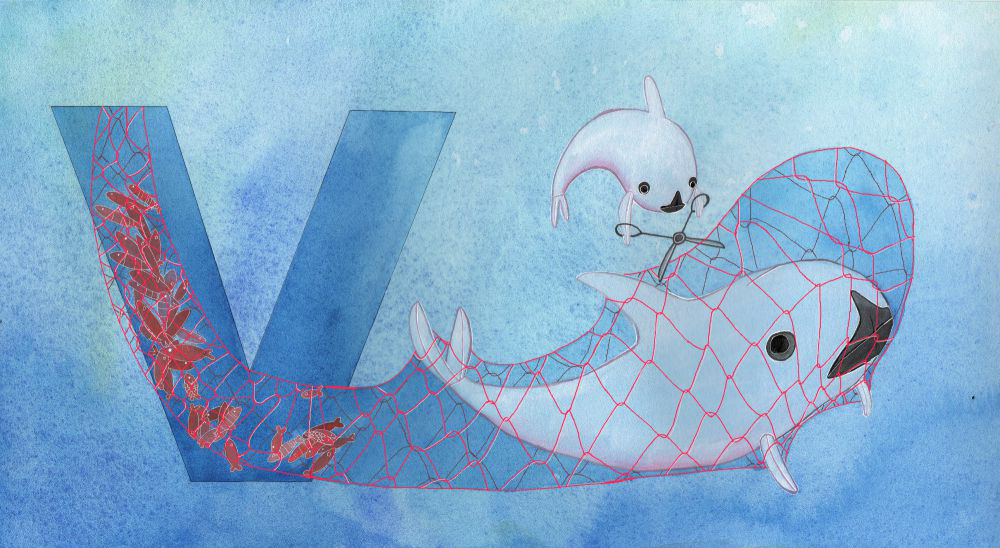
The Vaquita (Phocoena sinus) is an aquatic marine mammal endemic to the northern part of the Gulf of California. It is a very rare species of porpoise that lives in shallow turbid lagoons along shorelines and it feeds on small fish, squid and crustaceans. Vaquita is critically endangered, being considered the most endangered marine mammal species. It's been recently estimated that only 30 individuals remain. The primary threat two vaquitas is accidental drowning in gillnets meant for catching toboata fishes. In addition, the habitat of vaquitas is small and their food supply and health is affected by pollutants and water quality. Nowadays the population is so small that is suffering of low genetic variability. The vaquita is an evolutionary distinct animal, it has no close relatives and so it represents a top priority for conservation campaigns.
In my illustration baby vaquita is freeing its mum trapped in a fishing net.
In my illustration baby vaquita is freeing its mum trapped in a fishing net.

The whooping crane (Grus americana) is a big north American crane that nests in marshes. The destruction of its habitat and hunting have decimated whooping cranes and the total population counts only about 600 individuals. In the last century, the conservation efforts settled protected areas leading to a mild recovery of the whooping crane population. The Wood Buffalo National Park (Canada) was the last remnant of former nesting habitat, even if after a recent conservation project whooping cranes have nested naturally in Necedah National Wildlife Refuce (USA).
In my illustration a whooping crane is about to leave with her nest and eggs towards an intact habitat.
In my illustration a whooping crane is about to leave with her nest and eggs towards an intact habitat.

The Xanthophrine Tigerina is also known as Amboli Toad. It is a yellowish toad with dark stripes on top and sides of the body. It is endemic to Amboli, Maharashtra state, in the Western Ghats of India. Xanthophrine Tigerina is considered "Critically Endangered" because it is known from this single location only and its estimated area of occupancy is presumed to be less than 10 km2. Moreover the area where this species occurs is experiencing loss of forest cover and its habitat is considered to be severely fragmented.
In my illustration the toad is taking care of her tadpoles.
In my illustration the toad is taking care of her tadpoles.

The yellow eyed penguin (Megadyptes) antipodes is native to New Zealand, where it is known also with his Maori name, hoio. The species is characterized by a band of bright yellow running from its eyes around the back of the head. It breeds on the coasts of the South Island of New Zealand and of the nearby small islands with an estimated population of only about 4000 individuals. The species is listed as Endangered on the Red List of IUCN because it is confined to a very small range and its population has undergone a very rapid decline over the past three generations. The main ongoing threats are invasive predators, fisheries bycatch, human disturbance from unregulated tourists at breeding areas and habitat degradation. In particular modelling has found a likely correlation between changing sea surface temperature and penguin vital rates.
In my illustration two penguins are sailing looking for cooler waters.
In my illustration two penguins are sailing looking for cooler waters.
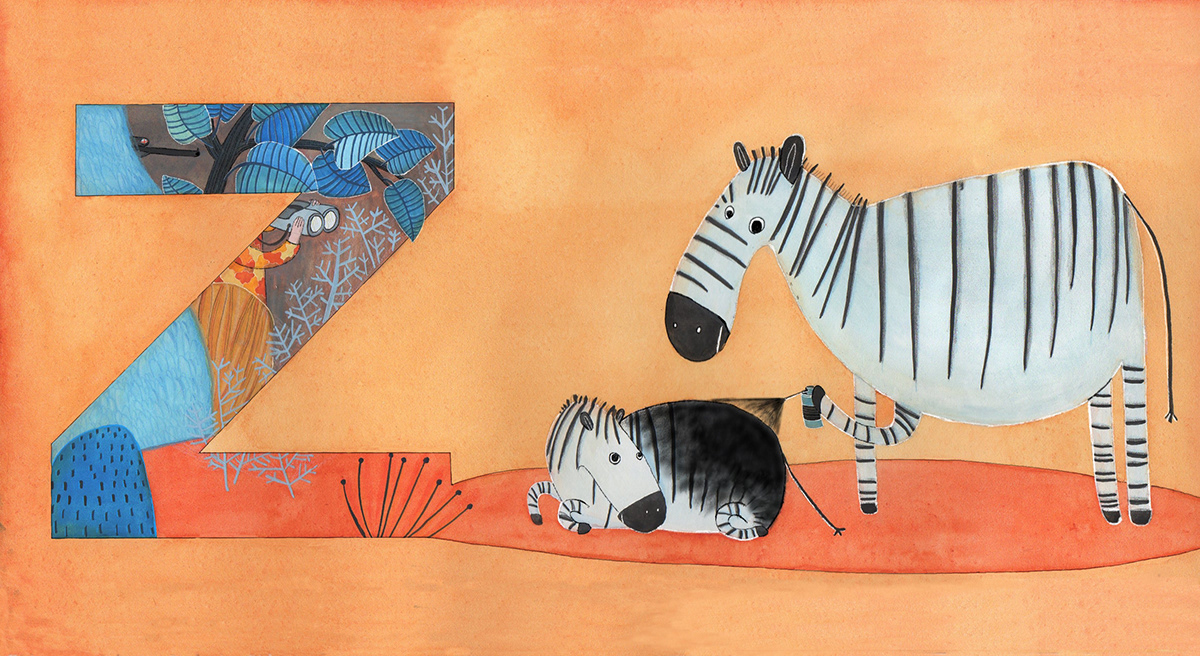
Three species of zebra exist: plain zebras, mountain zebras and Grévy's zebras (Equus Quagga, Equus zebra, Equus Grevyi). Zebras are African equids characterised by their distinctive black-and-white striped coats, which are unique to each individual. Many hypotheses have been proposed to account for the evolution of the striking stripes of zebras, which are traditionally considered related to camouflage. Unfortunately due to their unique stripes, zebras were, and still are, hunted for skins and in particular mountain zebras were hunted near to extinction at the beginning of the XX century. Other anthropogenic factors have had a severe impact on all the zebra populations for habitat fragmentation and degradation. Nowadays the three species are considered as vulnerable or endangered.
In my illustration zebra and her colt trying to hide their stripes in order to deceive hunters.
In my illustration zebra and her colt trying to hide their stripes in order to deceive hunters.
Follow the contest by @AnimalAlphabets: each monday on Twitter @GiuliaMaidecchi!
Thank you!


